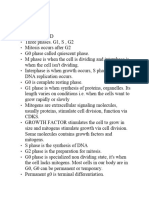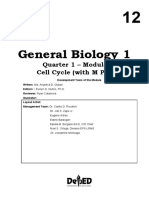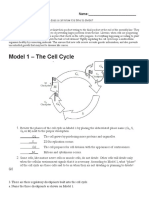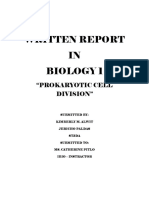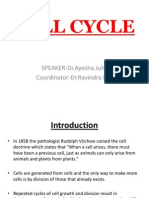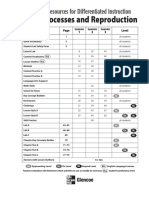0 ratings0% found this document useful (0 votes)
320 viewsBiology
Biology
Uploaded by
VIVEKThis document contains the answers to 16 questions about cell division and the cell cycle provided by a student named Vivek Singh with student ID number 15CS01019. Key points addressed include:
1) Cell division is important for both unicellular and multicellular organisms to reproduce and replace dead/damaged cells.
2) Cell division remains important after development for tissue renewal and wound healing.
3) Differentiation is when cells specialize in structure/function. Apoptosis is programmed cell death to eliminate unneeded/damaged cells.
4) Regulators stimulate or halt cell division, differentiation, or death; improper regulation can cause too few/many cells and tumors.
Copyright:
© All Rights Reserved
Available Formats
Download as DOCX, PDF, TXT or read online from Scribd
Biology
Biology
Uploaded by
VIVEK0 ratings0% found this document useful (0 votes)
320 views3 pagesThis document contains the answers to 16 questions about cell division and the cell cycle provided by a student named Vivek Singh with student ID number 15CS01019. Key points addressed include:
1) Cell division is important for both unicellular and multicellular organisms to reproduce and replace dead/damaged cells.
2) Cell division remains important after development for tissue renewal and wound healing.
3) Differentiation is when cells specialize in structure/function. Apoptosis is programmed cell death to eliminate unneeded/damaged cells.
4) Regulators stimulate or halt cell division, differentiation, or death; improper regulation can cause too few/many cells and tumors.
Original Description:
biology
Copyright
© © All Rights Reserved
Available Formats
DOCX, PDF, TXT or read online from Scribd
Share this document
Did you find this document useful?
Is this content inappropriate?
This document contains the answers to 16 questions about cell division and the cell cycle provided by a student named Vivek Singh with student ID number 15CS01019. Key points addressed include:
1) Cell division is important for both unicellular and multicellular organisms to reproduce and replace dead/damaged cells.
2) Cell division remains important after development for tissue renewal and wound healing.
3) Differentiation is when cells specialize in structure/function. Apoptosis is programmed cell death to eliminate unneeded/damaged cells.
4) Regulators stimulate or halt cell division, differentiation, or death; improper regulation can cause too few/many cells and tumors.
Copyright:
© All Rights Reserved
Available Formats
Download as DOCX, PDF, TXT or read online from Scribd
Download as docx, pdf, or txt
0 ratings0% found this document useful (0 votes)
320 views3 pagesBiology
Biology
Uploaded by
VIVEKThis document contains the answers to 16 questions about cell division and the cell cycle provided by a student named Vivek Singh with student ID number 15CS01019. Key points addressed include:
1) Cell division is important for both unicellular and multicellular organisms to reproduce and replace dead/damaged cells.
2) Cell division remains important after development for tissue renewal and wound healing.
3) Differentiation is when cells specialize in structure/function. Apoptosis is programmed cell death to eliminate unneeded/damaged cells.
4) Regulators stimulate or halt cell division, differentiation, or death; improper regulation can cause too few/many cells and tumors.
Copyright:
© All Rights Reserved
Available Formats
Download as DOCX, PDF, TXT or read online from Scribd
Download as docx, pdf, or txt
You are on page 1of 3
NAME- VIVEK SINGH
NO.:15CS01019
ROLL
1. Why is cell division important for both unicellular and
multicellular organisms?
Ans : This is because Cell division is the only way single-celled
organisms can reproduce and in case of multicellular organisms, they
need cell division to grow and to replace dead or damaged cells.
2. Why does cell division remain important to an adult
organism even after it is fully developed?
Ans: After growth, division remains important in normal cell turnover,
such as in our skin and gut, where cells are continuously renewed.
Other cells have to divide to heal wounds like skin cuts or broken
bones.
3. Cells divide, differentiate, or die. What is differentiation?
Ans: Cells divide to produce two identical daughter cells. Cells stop
dividing to specialize in structure and function, a process called
differentiation. Once differentiated, some cells may divide again under
certain conditions.
4. What is apoptosis? What is its purpose?
Ans: Cells can also undergo programmed cell death, or apoptosis, a
process that eliminates unnecessary cells during development and
removes unhealthy or damaged cells in the mature organism.
5. What are cell cycle regulators?
Ans: Cell cycle regulators are molecular signals that may stimulate or
halt cell division, instruct cells to differentiate, or initiate cell death.
6. What happens if cell cycle regulators dont function
properly?
Ans: If regulators dont function properly, an organism may end up with
too few or too many cells. This can cause problems of varying severity
from harmless hair loss or the growth of warts to the development of
life-threatening tumors.
7. Cells go through periods of growth and division. Cell division occurs
during mitotic phase.
8. The rest of the cell cycle is called interphase, during which a cell
grows and replicates its DNA.
9. (a) G1 phase:- During this phase, the cell increases in size and
prepares to replicate its DNA. Toward the end of G1, the cell has to be
sufficiently healthy to replicate its DNA. If the DNA is undamaged and
enough resources are available for the cell to keep growing and divide,
growth signals will stimulate the cell to proceed to the DNA synthesis,
or S, phase. Otherwise, either the cell dies or it enters a resting state,
also referred to as G0 phase.
(b)G2 phase:- During this phase, the cell continues to grow and
prepares for division.
To proceed to the next phase, all chromosomes have to be fully
replicated and contain no other types of damage. Only then can it
enter mitosis, or M phase, and divide. Protein synthesis and formation
of organelle takes place here.
(c)S phase:-The cell replicates its DNA. At the end of this phase, the
cell has two complete sets of chromosomes. Throughout the S phase,
DNA is continuously monitored for replication errors. If DNA synthesis
progresses without errors, growth signals will stimulate the cell to
proceed to G2, during which the cell matures.
10. In general, what is the purpose of a checkpoint in the cell
cycle?
Ans:- Checkpoints ensure that all the processes are going correctly, if
not so, it will stop the further processes and reverse the process to
make it correct.
11. What is the G0 phase of the cell cycle? Which factors
determine whether a cell enters G0? Can cells leave G0?
Ans: Toward the end of the G1 phase, a cell can "exit" the cell cycle
when it receives a signal to differentiate, or when resources are
insufficient to grow and divide. Whether or not a cell exits the cell cycle
depends on the organisms stage in development, the type of cell, and
the resources available. The cell is then said to be in G0a resting, or
nondividing, stage. Yes cells can leave G0.
12. What are cell cycle regulators?
Ans:- Cell cycle regulators are proteins that control the progression of a
cell through the cell cycle and can either stimulate or inhibit cell cycle
progression.
a. Stimulatory proteins are encoded by protooncogenes.
Examples include:- cyclin-dependent kinases (CDKs)
b. Inhibitory proteins are encoded by tumor suppressor genes.
Examples include:- cyclin-dependent kinases (CDKs)
13. Cancer is the result of an improperly regulated cell cycle.
Describe two reasons why cells can form Tumors.
Ans: - Cancer results from an improperly regulated cell cycle. As a
result, cells replicate indefinitely and form tumors.
14. In some types of colon cancer, stem cells have a mutation
in the APC gene. What happens if the APC gene is mutated?
Ans:-Mutations in the APC gene are also responsible for a disorder
called Turcot syndrome, which is closely related to familial
adenomatous polyposis. Turcot syndrome is an association of colorectal
cancer with a type of cancerous brain tumor called a medulloblastoma.
15. Normally, proto-oncogenes stimulate the cell cycle. What
are oncogenes and how do they affect the cell cycle?
Ans:- Proteins that normally stimulate the cell cycle are encoded
by proto-oncogenes. Mutated versions of these genes,
called oncogenes, are analogous to putting the foot on the accelerator,
increasing stimulation.
a. To cause cancer, proto-oncogenes require one allele(s) to be
mutated and
therefore are considered dominant. The mutation results in a gain of
function.
16. Normally, tumor suppressor genes inhibit the cell cycle.
How do mutated tumor suppressor genes affect the cell cycle?
Ans:- a. To cause cancer, tumor suppressor genes require two allele(s)
to be mutated and therefore are considered recessive. The mutation
results in a loss of function.
You might also like
- Hhmi Cell Cycle and Cancer - CompletedDocument3 pagesHhmi Cell Cycle and Cancer - CompletedAbel82% (11)
- The Complete Biomonster Vocabulary Reference GuideDocument26 pagesThe Complete Biomonster Vocabulary Reference Guideapi-110789702100% (1)
- MELCs (Biology 1 & 2)Document5 pagesMELCs (Biology 1 & 2)Sab Ibarreta91% (11)
- Disorders and Diseases That Result From The Malfunction of The Cell During The Cell CycleDocument2 pagesDisorders and Diseases That Result From The Malfunction of The Cell During The Cell CycleAmelyn Lingbawan100% (3)
- BiologyDocument3 pagesBiologyVIVEK100% (1)
- Nicha-Cellcycle-Overview 1Document6 pagesNicha-Cellcycle-Overview 1api-452284231100% (1)
- PreciadoGarcía Fátima BiologyII 45BBDocument5 pagesPreciadoGarcía Fátima BiologyII 45BBFatima PreciadoNo ratings yet
- Cancer Cell CycleDocument2 pagesCancer Cell Cyclelauravilasboas2008No ratings yet
- Cell Biology HHMI OverviewDocument6 pagesCell Biology HHMI Overviewbrodrickmursik7No ratings yet
- Lesson 6 - Cell Cycle and CheckpointsDocument6 pagesLesson 6 - Cell Cycle and CheckpointsReuben Al'jaldi100% (1)
- Cell Cycle Handouts - PDF (Highlighted)Document4 pagesCell Cycle Handouts - PDF (Highlighted)Shien VarronNo ratings yet
- Regulation of Cell Division: DR Sri WidyartiDocument49 pagesRegulation of Cell Division: DR Sri WidyartiMaheer JoefrieNo ratings yet
- Cell Cycle and CheckpointsDocument12 pagesCell Cycle and Checkpointsjayyyyyrg16No ratings yet
- Please Write Your Answer Briefly and ConciselyDocument7 pagesPlease Write Your Answer Briefly and ConciselyFRISKA CHRISTININGRUMNo ratings yet
- CELL CYCLE PPT KimDocument33 pagesCELL CYCLE PPT KimNeo RilloNo ratings yet
- The Cell CycleDocument26 pagesThe Cell Cyclerubayet.adbirNo ratings yet
- Cell Cycle CheckpointsDocument6 pagesCell Cycle CheckpointsJoyce NoblezaNo ratings yet
- 11 - 8 Deep Thinking QuestionsDocument3 pages11 - 8 Deep Thinking QuestionsbhaiisagendaNo ratings yet
- Cell CycleDocument7 pagesCell Cyclerey.quimno002No ratings yet
- Week 3 Modules Grade 12Document13 pagesWeek 3 Modules Grade 12Joe NasalitaNo ratings yet
- ch3 BioDocument19 pagesch3 Biosaidoddapaneni18No ratings yet
- UNIT 4 Cell CycleDocument24 pagesUNIT 4 Cell CycleChennille Ann Bleu GundayaoNo ratings yet
- Cell Cycle (Rubina)Document35 pagesCell Cycle (Rubina)RubinaNo ratings yet
- IJSO Biology Module - 1Document137 pagesIJSO Biology Module - 1Ikhbaat Atiqur Rehman100% (1)
- Eukaryotic Cell CycleDocument96 pagesEukaryotic Cell CycleRaghav Oberoi100% (1)
- Lab 7 - Cancer Biology-2022Document19 pagesLab 7 - Cancer Biology-2022jaelingabire05No ratings yet
- Cell ModificationsDocument8 pagesCell ModificationsKriezhel Kim TadleNo ratings yet
- Metaphase: Genome Mitosis Mitotic SpindleDocument2 pagesMetaphase: Genome Mitosis Mitotic SpindleYut3No ratings yet
- Cell Cycle (Scitable)Document2 pagesCell Cycle (Scitable)LibrofiloNo ratings yet
- PDF 20220916 020021 0000Document23 pagesPDF 20220916 020021 0000krishnu VNo ratings yet
- Cell DivisionDocument25 pagesCell DivisionanonjeraldineNo ratings yet
- M2L1 ActivateDocument2 pagesM2L1 ActivateVenice De los ReyesNo ratings yet
- Cell CycleDocument15 pagesCell CycleRhea GulayNo ratings yet
- Cell Cycl1Document3 pagesCell Cycl1Cric FreakNo ratings yet
- GB1 - W4 Module 2 1st QTR 1Document145 pagesGB1 - W4 Module 2 1st QTR 1AyaNo ratings yet
- AP Biology Lab-04Document20 pagesAP Biology Lab-04ldlewis0% (3)
- D 11 53 5F0DB470BB61DDocument79 pagesD 11 53 5F0DB470BB61DNeelanjan BhowmikNo ratings yet
- Cell CycleDocument16 pagesCell CycleMuhammad UmerNo ratings yet
- Lesson 5 Cell Cycle ContinuationDocument17 pagesLesson 5 Cell Cycle ContinuationKamaki RyuNo ratings yet
- Eukaryotic cell-WPS OfficeDocument22 pagesEukaryotic cell-WPS OfficeshowhomalihluvmoNo ratings yet
- Cancer in BiologyDocument12 pagesCancer in BiologyDure ShahwarNo ratings yet
- Imported FileDocument3 pagesImported Filekorkmazberrak8No ratings yet
- Cell Cycle Inquiry - DPDocument5 pagesCell Cycle Inquiry - DPYuree ChoiNo ratings yet
- Written Report IN Biology 1: "Prokaryotic Cell Division"Document5 pagesWritten Report IN Biology 1: "Prokaryotic Cell Division"Rodel Barro AlwitNo ratings yet
- S-B-4-1 - Cell Cycle Worksheet and KEYDocument3 pagesS-B-4-1 - Cell Cycle Worksheet and KEYCamille Sison-AlmirolNo ratings yet
- Lesson-General Biology-Cell-CycleDocument26 pagesLesson-General Biology-Cell-Cyclenashtrisha926No ratings yet
- Cell Cycle DefinitionDocument5 pagesCell Cycle DefinitionKristine Grace VillanuevaNo ratings yet
- Cell BiologyDocument24 pagesCell BiologySheelendra Mangal BhattNo ratings yet
- Cell Cycle and Cell DivisionDocument4 pagesCell Cycle and Cell Divisionchar montejeroNo ratings yet
- Cell CycleDocument22 pagesCell CycleMUHAMMAD KHANNo ratings yet
- Cell CycleDocument20 pagesCell CycleShelrenNo ratings yet
- Cell DivisionDocument3 pagesCell DivisionKaith Ashlee De LeonNo ratings yet
- Cell Bio AssignmentDocument11 pagesCell Bio AssignmentPranay PatnaikNo ratings yet
- Cell DivisionDocument4 pagesCell DivisionHajie RosarioNo ratings yet
- An Overview of Cell Cycle (Lec # 3)Document6 pagesAn Overview of Cell Cycle (Lec # 3)Izhar HussainNo ratings yet
- Unit 1Document52 pagesUnit 1Dsce BtNo ratings yet
- CANCER BIOLOGY and CHEMOTHERAPYDocument19 pagesCANCER BIOLOGY and CHEMOTHERAPYDennis Nabor Muñoz, RN,RMNo ratings yet
- Cell Division and Genetic Inheritance - FormattedDocument24 pagesCell Division and Genetic Inheritance - FormattedAISHA MUHAMMADNo ratings yet
- Cellcycle HardDocument8 pagesCellcycle HardKrizzy EstoceNo ratings yet
- Cell Cycle: SPEAKER-Dr - Ayesha.Juhi Coordinator-Dr - Ravindra.P.NDocument38 pagesCell Cycle: SPEAKER-Dr - Ayesha.Juhi Coordinator-Dr - Ravindra.P.NAyesha SKNo ratings yet
- Cell Junctions, Cell-Cell AdhesionsDocument36 pagesCell Junctions, Cell-Cell AdhesionsRizky Nur IndahNo ratings yet
- Biology Tie Wazaelimu - Com Form FiveDocument370 pagesBiology Tie Wazaelimu - Com Form Fivekhayrikhan0No ratings yet
- Reading Passage 9Document12 pagesReading Passage 9Kylie GolindangNo ratings yet
- Modul Science Form 1Document31 pagesModul Science Form 1Norafiza HashimNo ratings yet
- Grade 9 Natural Science - Teacher GuideDocument189 pagesGrade 9 Natural Science - Teacher Guidefshlog001No ratings yet
- Lp-Final CellsDocument3 pagesLp-Final CellsKresha LluismaNo ratings yet
- Released: North Carolina READY End-of-Course Assessment BiologyDocument30 pagesReleased: North Carolina READY End-of-Course Assessment BiologyMatthew SteinNo ratings yet
- Exp. 4 Lipid Extraction and Lipid Tests - DocxDocument7 pagesExp. 4 Lipid Extraction and Lipid Tests - DocxDe AlaipNo ratings yet
- 2023 JUPEB Past Questions (Biology)Document15 pages2023 JUPEB Past Questions (Biology)olokodoc2100% (1)
- Module 3 - Transport MechanismDocument12 pagesModule 3 - Transport MechanismVynch jyd bachinichaNo ratings yet
- Licensure Examination For Teachers Practice TestDocument29 pagesLicensure Examination For Teachers Practice Testapi-286466377100% (1)
- Zoo101 (Lec) Assignment - Cell Growth and ReproductionDocument11 pagesZoo101 (Lec) Assignment - Cell Growth and ReproductionJanaCasandra ManitiNo ratings yet
- Class IX Biology Book Chapter 02Document21 pagesClass IX Biology Book Chapter 02myNoteslibrary50% (2)
- 1 Comparing Plant and Animal CellDocument9 pages1 Comparing Plant and Animal CellLouise Meara Severo100% (1)
- BiologyDocument6 pagesBiologyArchanaNo ratings yet
- CH 8Document106 pagesCH 8Caitlin HurleyNo ratings yet
- Your Passport To A Career in BioinformaticsDocument84 pagesYour Passport To A Career in Bioinformaticsender000100% (2)
- Mader16e Chapter01 TBDocument7 pagesMader16e Chapter01 TBmNo ratings yet
- Chapter 13 RNA Test NAME Abdullah Alabdullah CLASS 9A DATEDocument7 pagesChapter 13 RNA Test NAME Abdullah Alabdullah CLASS 9A DATEAbdullah AlabdullahNo ratings yet
- Syllabus GKET 2022Document17 pagesSyllabus GKET 2022782008laluNo ratings yet
- Topicwise Test Schedule of AIATS For AIPMT / AIIMS 2016: For Class 12th Studying / Passed StudentsDocument2 pagesTopicwise Test Schedule of AIATS For AIPMT / AIIMS 2016: For Class 12th Studying / Passed StudentsPranav GargNo ratings yet
- An Update On Prunus Armeniaca Phytochemical Composition and Biological ActivitiesDocument7 pagesAn Update On Prunus Armeniaca Phytochemical Composition and Biological ActivitiesDenice JercqueNo ratings yet
- Science7 Q2 Module2Week3Document13 pagesScience7 Q2 Module2Week3Kimberly PradoNo ratings yet
- Laboratory 3Document14 pagesLaboratory 3Allexcia AguilaNo ratings yet
- Q2 - Module 5 DNA RNADocument14 pagesQ2 - Module 5 DNA RNAnormalguy34kNo ratings yet
- M.sc. ZoologyDocument2 pagesM.sc. ZoologySania AhmadNo ratings yet
- Lesson Plan Sem 20234 Bio400Document2 pagesLesson Plan Sem 20234 Bio4002023448462No ratings yet
- BIO 275 - Chapter 3 and 4 QuestionsDocument3 pagesBIO 275 - Chapter 3 and 4 QuestionsLindsey StilleyNo ratings yet

































